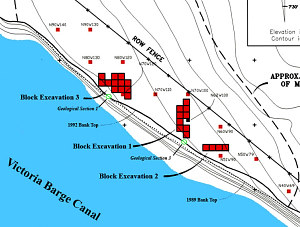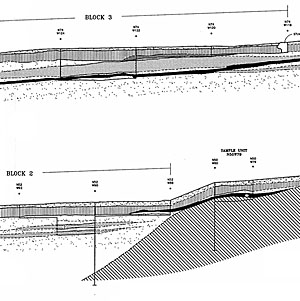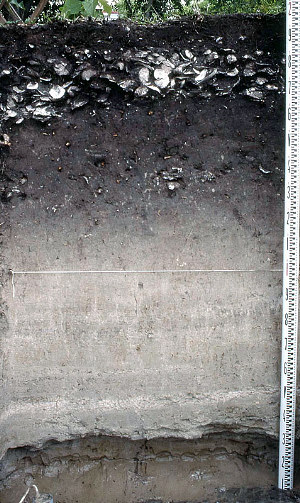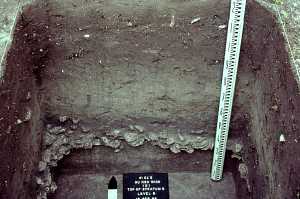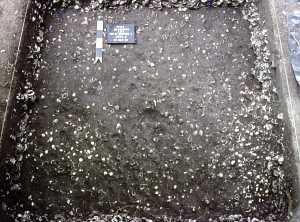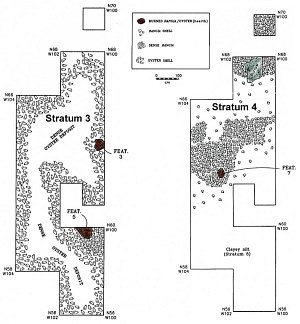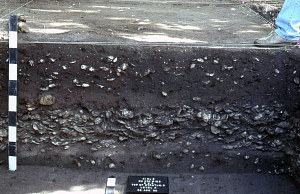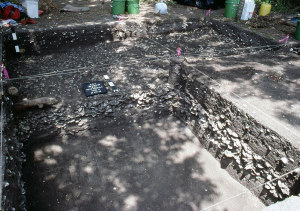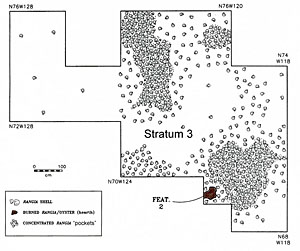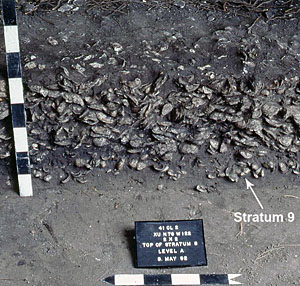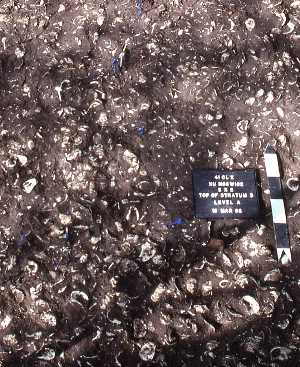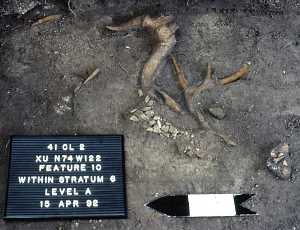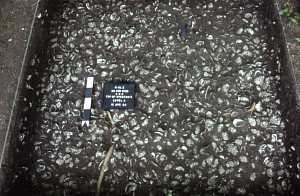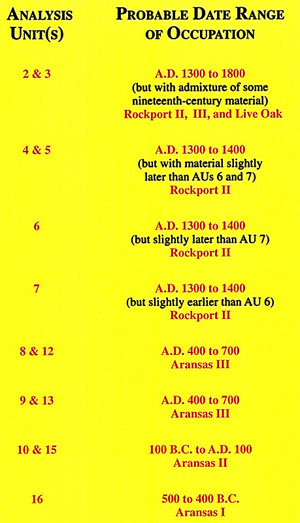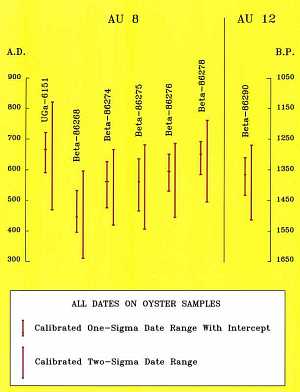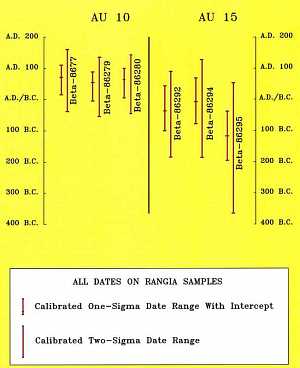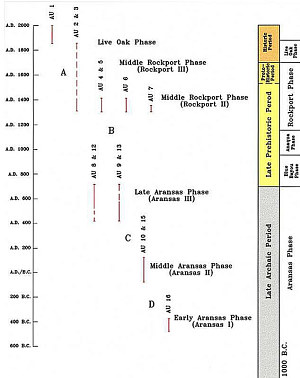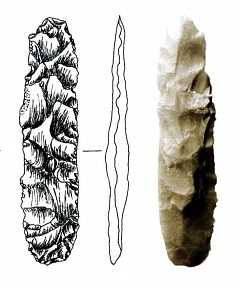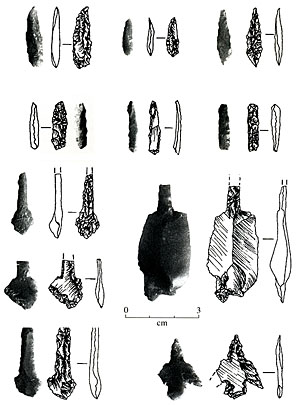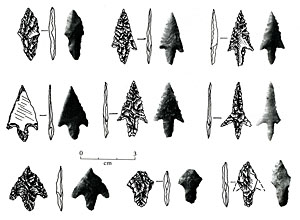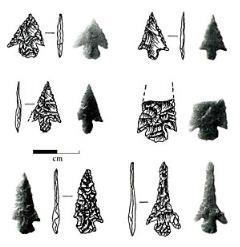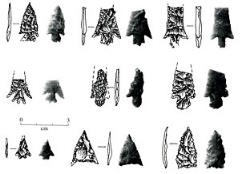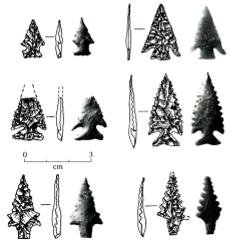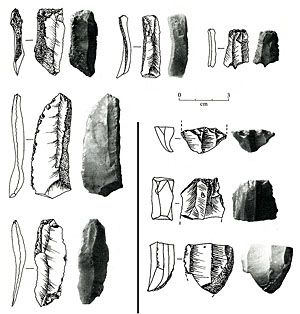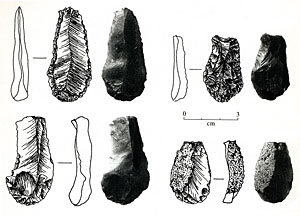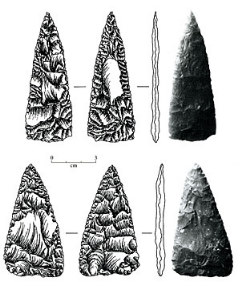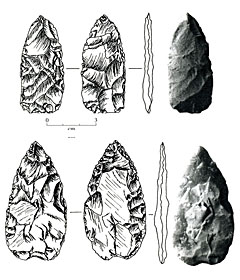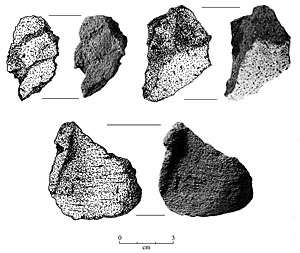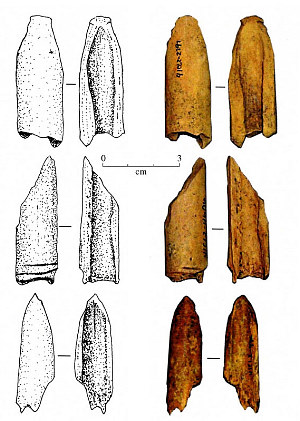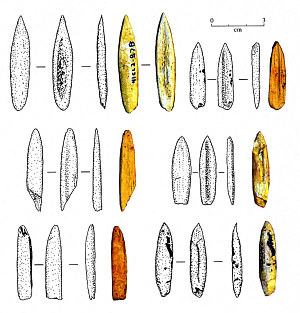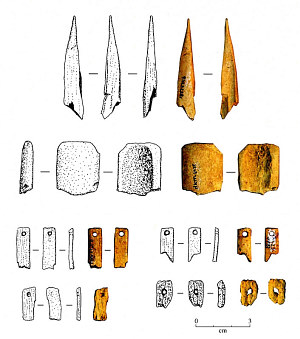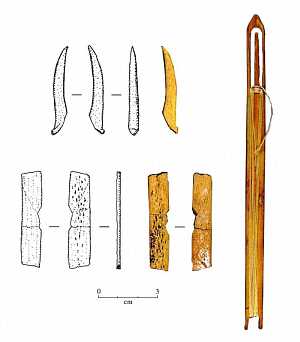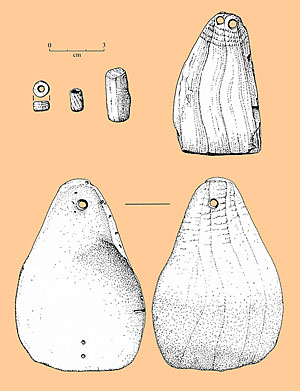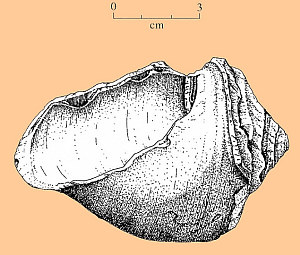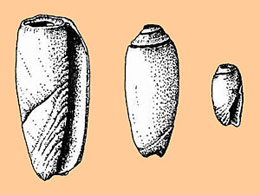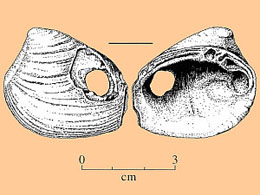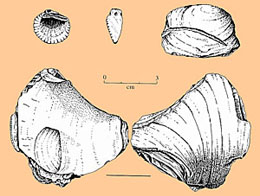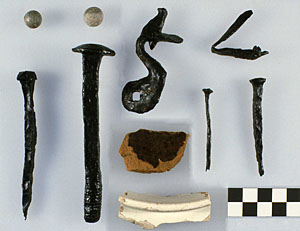Evidence
|
Modern archeological investigations like that of the Guadalupe Bay site focus on the recovery of detailed evidence to address targeted research problems. This approach can be contrasted with that taken in the “old days,” for instance the late 1930s excavation of Morhiss Mound. Archeologists of that era knew little about the archeological record and they focused on discovery and the recovery of a great many artifacts, mostly the finished tools and obvious artifacts. This was before radiocarbon dating and before archeologists gained an appreciation of how much could be learned from the recovery of fragmentary animal bones and the like. Their methods were rudimentary by today’s standards and their questions about the past were broad and unsophisticated. Compared to the big digs at Morhiss and elsewhere in the early to mid 20th century, the Guadalupe Bay site yielded far fewer complete artifacts and sampled a relatively small fraction of the site. But the information yield was vastly improved. This is why modern archeological investigations are the subject of highly detailed technical reports. In the case of Guadalupe Bay, the final report comprised 862 pages filling two volumes. Here we briefly summarize some of the critical data, mindful that readers interested in the details can and should consult the technical report. Most of the evidence presented here came from the three excavation blocks and nearby test units in the central part of the site. StratigraphyThe site’s stratification varies considerably across the roughly 100-meter-long slice (328 feet) through the site that was investigated along the barge canal right-of-way, as best seen in the accompanying composite site cross-section illustration. Overall, the cultural deposits were relatively dense, yet shallow and compressed at the southeast end of the site, while to the northwest they were relatively sparse, yet deeper and better stratified. Although early investigators perceived the site as “a shell midden,” in fact the site proved to have a series of discontinuous shell midden deposits, some consisting of mainly rangia, others mainly oyster, and still others with large numbers of both types of shell. The site’s cultural deposits formed over the last 2,500 years, with the earliest beginning in Late Archaic times about 400-500 B.C. These overlay Beaumont Formation deposits of clay loam, sandy loam and clay that formed during the late Pleistocene. These deep pre-human deposits were seen in four widely spaced geological profiles cut back into the eroded bankline along the barge canal. The stratigraphy of the core site area can best be seen by taking a closer look at the two largest, deepest, and most informative excavations, that of Block 1 and Block 3. The strata and cultural features identified in each of these areas are briefly described. Excavation Block 1Eight different strata and several features were recognized in Block 1. Stratum 1 was represented by a very dark brown to black sandy clayey colluvial deposit . Stratum 2 consisted of black fine sandy clayey silt that included scattered rangia and oyster shells and the vast majority of the artifacts acquired in the Block 1 excavations. Based on the large number of arrow points and aboriginal pottery, it clearly represented the remains of a relatively intense Late Prehistoric occupation in the area around Block 1. Stratum 3 was identified by a thick and dense oyster midden within a very dark gray to black fine sandy clayey silt matrix. This deposit was thickest at the south end of the block. Its presence was one of the main reasons for the excavation of Block 1. It was discovered that Stratum 3 almost certainly represents the remains an extensive Late Archaic occupation. Two features and two isolated pockets of rangia shell were recognized within the upper part of Stratum 3. Feature 3 consisted of a scatter of fired clay lumps, charcoal, burned bone, and a small amount of burned shell thought to represent the remains of a small, badly disturbed, Late Archaic hearth. Feature 5 was a cluster of burned rangia shells surrounded by a concentrated pocket of rangia shells, that most likely were part of the same collecting and discard episodes. Beneath the Stratum 3 oyster lens was Stratum 4, a layer of Rangia cuneata shells within a very dark fine sandy clayey silt matrix. At the very base of Stratum 3 was a concentration of burned rangia shell designated Feature 7 that analysis demonstrated undoubtedly were once part of Stratum 4. Underlying Stratum 4 in the northern part of Block 1 and Stratum 3 in the southern part of the block was Stratum 5, a very dark fine sandy clayey silt that contained minor amounts of caliche nodules and scattered rangia and oyster shells. It probably represents colluvial and/or alluvial deposition at a time when site occupation was minimal. Beneath this was a thin lens of oyster shells and abundant caliche identified as Stratum 7. The basal deposit encountered during the excavations in Block 1, Stratum 8, consisted of a dark fine sandy silt with abundant caliche nodules representing a non-cultural colluvial and/or alluvial layer that had been deposited prior to aboriginal occupation of the site. Block 3Eleven different strata were recognized across the block. Stratum 1 was the same late colluvial deposit found in all other units across the site. Likewise, Stratum 2 was the same mixed rangia and oyster deposit seen in other excavation units at the site and representing part of the Late Prehistoric component at Guadalupe Bay. Stratum 3 consisted of a discontinuous layer of predominantly rangia shells just beneath the mixed shell of Stratum 2. Within Stratum 3 were four discrete “pockets” of concentrated shell that can usefully be characterized as discrete habitation units. Such isolated shell pockets are distinct entities and not just fortuitous remnants of a once widespread shell deposit that had become badly disturbed by bioturbation. The most interesting of the four shell pockets was located in the southeastern portion of the block, and was by far the most pronounced of the three pockets, averaging between 10 and 15 cm thick at its thickest points. Situated immediately to the southwest of the pocket was a small hearth identified as Feature 2 that consisted primarily of a central deposit of ash, charcoal, and burned shell surrounded by an outer ring of fired clay, burned caliche and burned shell. Because of these factors, it was the most obvious hearth encountered at the site. Taken together, the shell pocket and the hearth comprise what are considered to be two of the basic elements of an aboriginal shell midden; what Aten terms the “hearth/refuse pile couplet” at sites along the upper Texas coast. Their presence at Guadalupe Bay not only indicates that such couplets also occur at shell middens along the central Texas coast, but that the discrete shell pockets of Stratum 3 are truly isolated shell disposal areas representing discrete episodes of refuse discard. Beneath Stratum 3 were two dark-colored silt deposits of what appeared to be colluvial and/or alluvial fill, Stratum 4 and Stratum 6. Both contained very minor amounts of scattered rangia and oyster that had worked their way into the deposits through bioturbation. Stratum 5, like the overlying Stratum 3, consisted of three discontinuous areas of moderate to concentrated oyster shells within a fine sandy clayey silt matrix. Present within the deposit was another small hearth, identified as Feature 9, and a possible smaller hearth, recorded as Feature8. Together, the shell pockets and hearths represent additional examples of hearth/refuse pile couplets at Guadalupe Bay. Feature 8 was a very small cluster of burned oyster shells situated within the upper 3cm of the Stratum5 oyster deposit. Because of its small size, it is somewhat questionable whether this feature actually represented an intact hearth, or if it simply reflected the remains of a few burned oysters that happened to be discarded together. Neither charcoal nor ash was noted among the shells, nor was any evidence of in situ burning seen. However, small hearths within shell middens generally are of a relatively ephemeral nature and are not hot enough to fire the surrounding soil. Likewise, because of the composition of much of the fuel used in such features (grasses, small sticks, and twigs), small shell midden hearths do not always leave ash and charcoal for future collection by archeologists. Feature 9 was a more pronounced hearth that consisted of a main concentration of burned shell (primarily oyster), burned bone, and a good bit of charcoal. Dark stains found beneath the feature appeared to represent soil discolored by fire, suggesting that this hearth once was a rather substantial affair. A relatively thick and highly concentrated oyster lens was identified as Stratum 7 and contained an abundance of hooked mussels (Ischadium recurvum), undoubtedly by-products of intense oyster collecting. Stratum 8 was another noncultural layer of silt that probably represented a colluvial and/or alluvial deposit. . One of the more interesting of all cultural deposits located at Guadalupe Bay was Stratum 9, which included two slightly different substrata identified as Strata 9 and 9a. Stratum 9 consisted of a concentrated, but relatively thin, deposit of rangia shells within a very dark gray fine sandy silt matrix. Six small areas of concentrated rangia occurred within Stratum 9, two of which contained significant quantities of burned shells, and probably represent hearths. One was recorded as Feature 12 and nearby was a shell cluster identified as “Rangia Pocket 3,” that contained several bone fragments and scattered pieces of charcoal. A few burned rangia were noted, but not enough were recognized to allow the excavator to classify the pocket as a hearth during digging. Nevertheless, subsequent analysis of the burned/unburned ratio of shells from the pocket clearly indicates that it was a hearth. The other four rangia clusters most likely represent individual refuse piles similar to the larger shell pockets noted for Strata 3 and 5. Considering that two probable hearths (Feature 12 and Rangia Pocket 3) were present amongst the shell pockets, then together these provide other examples of hearth/refuse pile couplets at Guadalupe Bay. In addition to the hearth and discrete refuse piles, Stratum 9 contained perhaps the most interesting of all the features located at Guadalupe Bay. A concentration of deer bone, including several antler fragments and part of a deer skull with antlers still attached, designated Feature 10/13. (What were initially thought to be two separate features were recognized as one and the same as the excavations progressed.) The deposit was in direct association with the Stratum9 rangia layer. The bones covered an area measuring approximately 2meters in diameter and appeared to represent a deer butchering area associated with one of the earliest occupations at the Guadalupe Bay site. Beneath Stratum 9 in the northern portion of the block, and below Stratum 7 in the southern part, was Stratum 10, a dark clayey fine sandy silt of probable colluvial/alluvial origin. It represents the basal, noncultural layer upon which developed all aboriginal occupation in the area of Block3. Several excavation units extended beneath Stratum 10, uncovering a somewhat deeper noncultural deposit identified as Stratum 11. This deposit had a significantly greater quantity of caliche nodules than in any of the overlying strata, suggesting that it may, in part, be colluvial in origin. Analysis UnitsTwo principal methods were employed at Guadalupe Bay to unravel and date the aboriginal occupations responsible for the numerous midden deposits uncovered during excavation, firstly the establishment of “analysis units” followed by radiocarbon dating. Analysis units, or “AUs,” provide a convenient and manageable method of comprehending complicated stratigraphic situations across large areas of a site. Sixteen analysis units were created for Guadalupe Bay, principally relying on data from the three block excavations. Relatively thick strata were divided into different AUs, both spatially and stratigraphically. For instance, Stratum2, the site-wide, somewhat jumbled, rangia and oyster midden, was found to cover almost all of the site, and, in places, reached a thickness of 20 to 30 cm or more. It was divided into four different analysis units in an effort to detect possible spatial and chronological differences. Below each analysis unit is briefly characterized. Analysis Unit 1 consisted of Stratum 1 in the central portion of the site where the three block excavations occurred. Although it was initially thought that Stratum 1 was mainly a relatively late (post-1840s) colluvial deposit, it proved to have essentially the same range of mainly late Rockport materials found in underlying Stratum 2. Analysis Unit 2 was set up, along with AU 3, to cover what was believed to be the latter portion of the main aboriginal occupation at Guadalupe Bay. Although a few Live Oak phase artifacts were present within the analysis unit, the majority of the remains from AU2 came from a late (or “upper”) Rockport phase component. AU 2 was separated spatially from AU 3 in an effort to identify possible functional and/or social differences between the area around Blocks 1 and 2 and the area around Block 3. It also was kept separate from underlying AU4 in order to examine possible chronological differences during the overall Rockport occupation. Analysis Unit 3 was set up as a spatially distinct counterpart to AU 2 to examine what was thought to be late (or “upper”) Rockport material in the western part of the central site area, and to allow for comparisons between it and contemporaneous material from AU 2 in and around Blocks 1 and 2. Analysis Unit 4 was set up as a spatially distinct, but potentially contemporaneous, counterpart to AU 5 to examine the potential earlier (or “lower”) Rockport remains at Guadalupe Bay. As such, it was hoped that artifact comparisons between these units and overlying AUs 2 and 3 would help pinpoint frequency changes in ceramic and lithic types and varieties, plus ceramic decorative styles, and allow for chronological subdivision of the Rockport phase. Analysis Unit 5 was designed to look at the deeper, and thus earlier (or “lower”), Rockport material from Stratum 2 in the area around Block 3. It basically is the Block 3 counterpart to AU 4 in the area of Blocks 1 and 2. Analysis Unit 6 only occurred in and around Block3 and represents the discrete rangia shell deposits uncovered in that area. It represents the relatively undisturbed remains of specific Rockport phase disposal areas, probably not unlike those deposits that once comprised most of Stratum 2 before that stratum was affected by hundreds of years of subsequent tree falls and bioturbation. This analysis unit not only produced artifactual and faunal remains related to the Rockport phase, it included the best-preserved Rockport hearth (Feature 2) found at Guadalupe Bay. Analysis Unit 7 also occurred only in and around Block 3, and was represented by the Stratum 5 oyster deposit thought to be the potentially earliest Rockport deposit at Guadalupe Bay. This discrete habitation unit included two hearths (Features 8 and9). Analysis Unit 8 is the first of several Late Archaic analysis units defined for Guadalupe Bay. Basically, AU 8 included material from the first 10-cm thick cut into the upper part of the thick Stratum 3 oyster deposit in Block 1. It was kept separate from the lower part of the same stratum in the area of Blocks 1 and 2 (AU 9) in order to attempt to subdivide the stratum into more subtle chronological units. Two possible hearths (Features 3 and 5) were present in AU 8. Analysis Unit 9 included all secondary cuts into the Stratum 3 oyster deposit in Block1. Analysis Unit 10 is an extremely interesting analysis unit that originally included the Stratum 4 rangia deposit located in the northern part of Block. Subsequent data, including radiocarbon dates and artifactual analyses, suggested that a similar deposit in Block 2 most likely also is related. Thus, at least two separate shell deposits representing discrete habitation units comprise Analysis Unit 10. These are equivalent in age to AU 15, another highly intriguing rangia deposit located at the very bottom of the deep excavation units in Block 3. One possible hearth (Feature 7) was associated with AU10. Analysis Unit 11 does not represent an actual occupation layer, but instead consists of the noncultural colluvium and/or alluvium of Stratum 6 in Block 3. Analysis Unit 12 was represented by the initial cuts into the Stratum 7 oyster deposit in Block 3. Analysis Unit 13 included all items from the deeper cuts into the Stratum 7 oyster deposit in Block 3. As such, it most likely was equivalent in age to AU 9 in Block 1. Analysis Unit 14, like AU 11, consisted of what was believed to be the noncultural colluvial and/or alluvial deposit of Stratum 8 found near the base of the deep excavations in Block 3. Stratum 8 served to separate the overlying Stratum 7 oysters (AUs 12 and 13) from the underlying rangia of Strata 9 and 9a (AU 15). Analysis Unit 15 was represented by the Strata 9 and 9a rangia deposit located at the base of the deepest excavation units in Block 3, plus two possible hearths (Feature 12 and rangia Pocket 3) and a concentration of deer bone (Feature 10/13), the latter of which may represent an isolated butchering locus. Analysis Unit 16 probably was the earliest occupation at Guadalupe Bay. It was uncovered at the bottom of several of the deep 1-by-1-m units in Blocks 1 and 2. The chief factor distinguishing this analysis unit from those preceding it was the almost total lack of bone preservation, indicating greater age than any of the other deposits. A radiocarbon date associated with AU 16 was several hundred years earlier than any other at Guadalupe Bay, and indicated an occupation within the early portion of the Late Archaic period. Radiocarbon Dates and Site OccupationsThe second principal method of determining site chronology at Guadalupe Bay employed a suite of 42 radiocarbon dates obtained on shell, charcoal, or ash from the various excavation levels and features uncovered during the investigations. Each date was critically evaluated, some were eliminated and considered invalid because of obvious contamination from extremely old carbon. The pros and cons of applying correction factors to offset potential “reservoir effects” resulting from the presence of “dead” carbon in water absorbed during shell growth by different shellfish species was considered. Following this evaluation, the most likely radiocarbon age for each analysis unit (or combination of analysis units) was determined. The interested reader is directed to the lengthy discussion on radiocarbon dating in the published report to see exactly how the “acceptable” dates were corrected and manipulated. Overall, three definite aboriginal occupations occurred during the Late Archaic period, another two occupations took place during the Late Prehistoric period (one definite, one likely), and one each occurred during Protohistoric and Historic times. Evidence of a final Euro-American occupation dating to the mid 1800s also was found. Each occupation is reviewed in the Life at Guadalupe Bay section. Non-Pottery ArtifactsThe site’s massive collection of pottery is described in the Rockport Pottery section. Nevertheless, the outnumbered and outweighed “non-pottery” artifacts made of stone, bone, and shell proved quite insightful. Below we briefly characterize each category and use many drawings and photographs to illustrate the wealth of evidence. Lithic ArtifactsThe excavations at the Guadalupe Bay site recovered a total of 23,291 stone objects, which included 1,015 tools (such as arrow points, scrapers, and drills), 18,101 pieces of lithic debitage (debris resulting from the tool-making process, such as flakes and discarded preforms), and 4,175 fragments of unmodified stone (mainly pumice). By far, the greatest number of tools consisted of 373 arrow points or fragments of arrow points. Of these 198 (53%) could be classified by type. The contracting-stem Perdiz arrow point style accounted for over 70% (144 specimens) of the identifiable points; Rockport assemblages are typically dominated by Perdiz points. The next most common was the Bulbar Stemmed style (34 specimens, 17% ), which is believed to date to the very end of the Late Prehistoric era and during Proto-historic times. Three varieties of Bulbar Stemmed were proposed in hopes that minor variations might reflect chronological differences. The Bulbar variety is the classic form, while the Calhoun variety has a very small bulb or protrusion near the center of the base and the base of the Rupley Lake variety has several tiny notches. There were also 13 Scallorn arrow points, the common expanding stem form that occurs widely across much of southern and central Texas. This type was the first arrow point introduced along the central Texas coast, perhaps around A.D. 700. It was replaced by Perdiz points after A.D. 1200. The remaining seven identifiable arrow points are late unstemmed styles including Lozenge (3), Cuney (2), Fresno, and Guerrero, the latter typically associated elsewhere with Mission Indians. Only a single dart point was recovered from Guadalupe Bay, a Middle Archaic-style Bulverde point that was found in Late Archaic contexts. |
|
|
Forty-two (15 complete and 27 partial) chipped stone artifacts had at least one narrow, pointed, distal end indicating that they were probably used as perforators. Wear along the blade margins and on the tips was frequently evident, suggesting their use as drills or awls. Surprisingly, given the relatively large lithic collection, there were only two fragments of stone hammers, both unmodified cobbles of a reddish-colored quartzite. Abraiders were much more common, including 15 pieces of sandstone and 5 of pumice that had worn surfaces. Numerous smaller fragments of pumice were found that may well represent pieces of broken abraiders. Bone Tools and OrnamentsBone artifacts were common at Guadalupe Bay and provide evidence of what could be called Rockport bone ornament and bone tool “industries.” A total of 30 bone beads was recovered. These were manufactured from longbone shafts of medium-sized birds and from shark vertebrae, and were found only in Rockport levels. All of the beads manufactured from bird longbones (n=19) were cut into short segments and had their edges beveled and smoothed. Shark vertebrae (n=11) are relatively small and must have come from juvenile (nonbreeding) sharks caught near shore in an estuarine habitat. Associated shark teeth suggest that these vertebrae are from juvenile bull sharks; however, considering the variability in the vertebrae themselves, at least two taxa are present At least two, possibly three, kinds of bone points were found at Guadalupe Bay. The first of these, and the earliest, was a “large” point style that appear to have been manufactured from deer femurs and metapodials. The marrow cavity is invariably very large (ca. 1 cm in diameter) and hafting may have involved inserting a wooden shaft into the bone. These points were present in some of the earliest levels of the site (Feature 10/13 in the specialized encampment dating to the Aransas II occupation), the intervening Aransas III component, plus a few of the lower Rockport levels. Manufacturing of this kind of point may have had a long tradition on the central Texas coast. The second type of bone point, also (usually) manufactured from large-mammal longbones, was smaller and lanceolate in outline with a pointed tip and a spatulate base. The bases of these “small” points had been ground until smooth, presumably to facilitate hafting (asphaltum was found on several of these). Reworking was common. The marrow cavity on the inside of the bone shaft was usually left in place, providing a “flute” against which a wooden shaft could be stabilized. All seventeen examples or possible examples of this kind of point were recovered only in Rockport levels. Although few small lanceolate bone points have been reported along the Texas coast, they are said to be very common along the Florida Gulf coast and thought to be associated with coastal fishing. Florida archeologist Karen Walker has suggested that these points could have been used as elements of composite fishhooks, spears, or leisters, or they may have been arrow points used for shooting fish. Bi-pointed examples, on the other hand, could have been employed as gorges. Support for the small bone points having a fishing-related function at Guadalupe Bay comes from the fact that most were found in the lower Rockport levels where intense fishing was documented by the vertebrate faunal remains. Likewise, the small points decrease in numbers in the upper Rockport levels where fishing apparently was less important, having been replaced to some extent by the hunting of large game. Several bone tools definitely related to fishing were recovered from Aransas III deposits including the barb portion of a composite bone fishhook, a complete netting needle and several netting needle fragments. Furthermore, it seems possible that some of the remaining tools of “unknown” function could relate to fishing activities. Shell ToolsAs might be expected from a shoreline campsite composed largely of shell midden deposits, shell artifacts were very common at Guadalupe Bay. Over three and a half thousand shell specimens exhibiting signs of modification or possible utilization patterns were recovered. Most were made from four shellfish species: Macrocallista nimbosa, Rangia cuneata, Crassostrea virginica, and Busycon perversum. One of the most commonly used shells was the sunray venus (Macrocallista nimbosa) with 539 specimens exhibiting intentional modification or possible modification. In his insightful 1988 review of the utilization of marine mollusks along the Texas coast, archeologist Gentry Steele explained that sunray was favored along the southern Texas coast because its dense structure allowed tool makers to use similar “flint knapping” techniques. The large number of flaked sunray venus fragments at Guadalupe Bay indicates that it was a favorite cutting tool employed by people living at the site. |
|
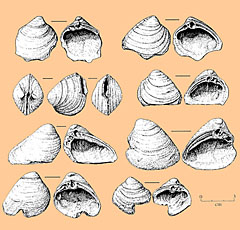
Rangia cuneata clam shells with edge damage and modification. Top row and second row left: with edge damage patterns interpreted as resulting from shucking. Second row right and third row left: with cut margins. Third row right and bottom row left: notched. Bottom row right, 90-degree snap fracture. Adapted from Weinstein 2002, Figure 9-8. |
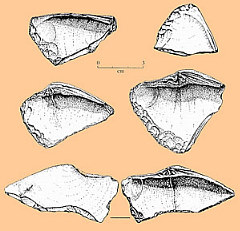
Sunray venus (Macrocallista nimbosa) scraping tools. There also were over 2000 fragments of sunray venus shell, some obviously flaked, grooved, or cut. Collectively, the tools and the many fragments representing manufacturing debris suggest that numerous tools were made from this durable clam shell at the Guadalupe Bay site, most of which used and discarded elsewhere. Adapted from Weinstein 2002, Figure 9-1. |
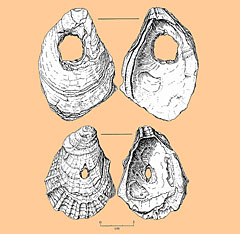
|
|
Nine hundred thirty-four Rangia cuneata valves exhibiting deliberate or consistent signs of modification (ca. 25 percent of the shell artifact sample) were separated out from the approximately eight tons of rangia shell removed during the investigations at Guadalupe Bay. These valves were then sorted into several groups. Most (n=592) were “edge-chipped” with uneven chipped margins that appear to be damaged by use in scraping motions, or in a few convincing cases, by shucking with a hard object. “Cut margin” rangia (n=84) had smoothed edges caused by apparent use in cutting or rubbing motions. rangia valves with “notched margins” (n=68) are characterized as having one or more purposeful notches taken out of the edges. Many show wear around the notch on both the concave and convex surfaces. “Perforated” rangia have deliberate holes punched or pecked through the body of the valve. Curiously, in all cases but four, the area selected for piercing is on the upper posterior half of the shell body. These could have been used for net or line weights. Rangia with “90° Snap Fracture” (n=127) were so-named to describe a curious fracture pattern seen on whole rangia valves. While there is no certain way of knowing whether the fracture is the result of human or natural causes, the consistency merits further description. Most of the valves show a smooth breakage of the ventral and posterior margins resulting in an approximate 90° snapped-out area where the two margins intersect. The purpose of this breakage pattern is unknown. A total of 244 oyster valves found at Guadalupe Bay show signs of modification. Over half are perforated and, of these, most are abraded on one or more margins. The remaining valves are either notched, chipped, cut, fragmented, or they exhibit a combination of these modifications on ventral, posterior, or anterior margins. It is interesting to note that the left or (lower) valve accounts for 74 percent of all modified oyster at the site. The lower valve is more robust than the upper valve and has a cupped shape to accommodate attachment at the umbo area to the substrate bed. The upper valve is thinner, flat and lid-like. Among the 145 perforated oyster valves in this collection, 95 percent are of the lower valve, indicating an overwhelming preference for the use of the lower valve for piercing and possibly hafting. Most have single perforations that are irregular in shape and located near the valve center, or higher near the umbo. Perforated oysters could have served differing functions depending upon the shape and size of the perforation; those with larger holes might have been used as a hafted implement, perhaps for digging or scraping, while valves with smaller holes could have facilitated fishing activities (as line sinkers, net weights, etc.). Non-perforated “notched and chipped” oyster valves (n=70) exhibited notching and abrasion along the ventral and/or lateral margins. Like the perforated group, many showed multiple patterns of chipping, flaking, grinding, nicks, v-shaped notches and cut marks. “Cut” oyster valves (n=25) had deliberate, straight-cut edges along the ventral or lateral margins, or they were cut longitudinally in half. While some of the cut edges could represent the byproduct of the oyster-shucking process, these are commonly described in the archeological literature as oyster knives. |
|
|
|
|
A total of 244 shell artifacts from Guadalupe Bay, both decorative and utilitarian, were fashioned from Busycon sp, probably lightning whelk. These included five beads, two bead blanks, two pendants, 18 worked columella fragments (eight with gouge-like anterior ends), five adze-like objects with cut margins made from whorl sections, six partially whole shells with signs of battering on the basal portion of some of the columella, three spire fragments, one Busycon cup or dipper, and 202 whorl fragments, some with cut edges. These are illustrated here and discussed in several other sections of the Coastal Prairies and Marshlands exhibit set. An additional 202 broken or partially cut whelk whorl fragments, and seven whole shells with intact spires but partially removed whorl sections are thought to represent debris left over from manufacturing activities There were smaller numbers of other shell species that showed evidence of use or manufacture. Twelve Oliva sayana shells and one Olivella minuta shell exhibit some alteration. Those cut or broken below the shoulder area were referred to as Oliva “tinklers," while the others, with lopped-off or ground-off spires, were called beads. Other shells included a perforated ark shell (Anadara ovalis), a fragment of a decorated mussel shell (Mytilidae sp.), a grooved mussel shell, three cut Mercenaria, and three unidentifiable fragments. |
|
